Publications
Please find the list of my publications.
2008
 W. Broll, I. Lindt, I. Herbst, J. Ohlenburg, A. Braun, and R. Wetzel.
Towards Next-Gen Mobile AR Games.
Computer Graphics and Applications 28(4): 40-48, 2008. PDF
W. Broll, I. Lindt, I. Herbst, J. Ohlenburg, A. Braun, and R. Wetzel.
Towards Next-Gen Mobile AR Games.
Computer Graphics and Applications 28(4): 40-48, 2008. PDF
 J. Ohlenburg, W. Broll, and I. Lindt.
Orchestration and Direction of Mobile MR Games.
Chi 2008 Workshop - Urban Mixed Realities: Technologies, Theories and Frontiers, 2008. PDF
J. Ohlenburg, W. Broll, and I. Lindt.
Orchestration and Direction of Mobile MR Games.
Chi 2008 Workshop - Urban Mixed Realities: Technologies, Theories and Frontiers, 2008. PDF
Abstract: Mobile Mixed Reality Games are embedded in the physical environment of a user and pose therefore new
requirements on design, authoring, orchestration and direction of the game. New supporting tools are
required to meet the challenges of such games and tocreate an exciting and coherent experience for the
users.
In this paper we focus on the aspects of orchestration and direction of Mobile MR Games and how tools can
support the developers and the people setting up such games. We highlight also the fact that supporting tools
might become an important game element.
2007
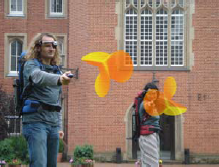 I. Lindt, J. Ohlenburg, U. Pankoke-Babatz, and S. Ghellal.
A Report on the Crossmedia Game Epidemic Menace.
In ACM Computers in Entertainment (CIE) volume 5, issue 1 (Jan. 2007), 2007. PDF
I. Lindt, J. Ohlenburg, U. Pankoke-Babatz, and S. Ghellal.
A Report on the Crossmedia Game Epidemic Menace.
In ACM Computers in Entertainment (CIE) volume 5, issue 1 (Jan. 2007), 2007. PDF
Abstract: Crossmedia games employ a wide variety of gaming interfaces based on stationary
and mobile devices to facilitate different game experiences within a single game. This article
presents the crossmedia game Epidemic Menace, introduces the game concept, and describes experiences
from two Epidemic Menace game events. We also explain the technical realization of Epidemic Menace,
the evaluation methodologies we used, and some evaluation results.
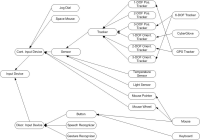 J. Ohlenburg, W. Broll, and I. Lindt.
A Device Abstraction Layer for VR/AR.
In International Conference on Human-Computer Interaction (HCI 2007), 2007. PDF
J. Ohlenburg, W. Broll, and I. Lindt.
A Device Abstraction Layer for VR/AR.
In International Conference on Human-Computer Interaction (HCI 2007), 2007. PDF
Abstract: While software developers for desktop applications can rely on
mouse and keyboard as standard input devices, developers of virtual reality (VR) and augmented
reality (AR) applications usually have to deal with a large variety of individual interaction
devices. Existing device abstraction layers provide a solution to this problem, but are usually
limited to a specific set or type of input devices. In this paper we introduce DEVAL – an
approach to a device abstraction layer for VR and AR applications. DEVAL is based on a device
hierarchy that is not limited to input devices, but naturally extends to output devices.
 M. Wittkämper, I. Lindt, W. Broll, J. Ohlenburg, J. Herling, and S. Ghellal.
Exploring Augmented Live Video Streams for Remote Participation.
In Conference on Human Factors in Computing Systems (CHI 2007), 2007. PDF
M. Wittkämper, I. Lindt, W. Broll, J. Ohlenburg, J. Herling, and S. Ghellal.
Exploring Augmented Live Video Streams for Remote Participation.
In Conference on Human Factors in Computing Systems (CHI 2007), 2007. PDF
Abstract: Augmented video streams display information within the context
of the physical environment. In contrast to Augmented Reality, they do not require special equipment,
they can support many users and are location-independent. In this paper we are exploring the
potentials of augmented video streams for remote participation. We present our design considerations
for remote participation user interfaces, briefly describe their development and explain the design
of three different application scenarios: watching a pervasive game, observing the quality of a
production process and exploring interactive science exhibits. The paper also discusses how to
develop high quality augmented video streams along with which information and control options are
required in order to obtain a viable remote participation interface.
2006
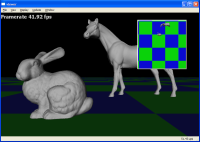 J. Ohlenburg and W. Broll.
Parallel multi-view rendering on multi-core processor systems.
In SIGGRAPH '06: ACM SIGGRAPH 2006 Research posters, 2006. PDF Poster
J. Ohlenburg and W. Broll.
Parallel multi-view rendering on multi-core processor systems.
In SIGGRAPH '06: ACM SIGGRAPH 2006 Research posters, 2006. PDF Poster
 I. Lindt, J. Ohlenburg, U. Pankoke-Babatz, W. Prinz, and S. Ghellal.
Combining Multiple Gaming Interfaces in Epidemic Menace.
In CHI '06: CHI '06 extended abstracts on Human factors in computing systems, pages 213-218, 2006. PDF
I. Lindt, J. Ohlenburg, U. Pankoke-Babatz, W. Prinz, and S. Ghellal.
Combining Multiple Gaming Interfaces in Epidemic Menace.
In CHI '06: CHI '06 extended abstracts on Human factors in computing systems, pages 213-218, 2006. PDF
Abstract: This paper presents the multiple gaming interfaces of the crossmedia
game Epidemic Menace, including a game board station, a mobile assistant and a mobile Augmented
Reality (AR) system. Each gaming interface offers different functionality within the game play.
We explain the interfaces and describe early results of an ethnographic observation showing how
the different gaming interfaces were used by the players to observe, collaborate and interact
within the game.
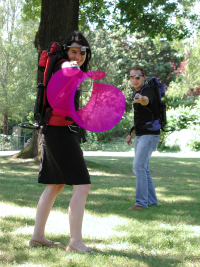 I. Lindt, J. Ohlenburg, U. Pankoke-Babatz, and S. Ghellal.
A Report on the Crossmedia Game Epidemic Menace.
ACM Computers in Entertainment (CIE), 5(1), 2007. PDF
I. Lindt, J. Ohlenburg, U. Pankoke-Babatz, and S. Ghellal.
A Report on the Crossmedia Game Epidemic Menace.
ACM Computers in Entertainment (CIE), 5(1), 2007. PDF
Abstract: Crossmedia games employ a wide variety of gaming interfaces based
on stationary and mobile devices to facilitate different game experiences within a single game.
This article presents the crossmedia game Epidemic Menace, introduces the game concept, and
describes experiences from two Epidemic Menace game events. We also explain the technical
realization of Epidemic Menace, the evaluation methodologies we used, and some evaluation
results.
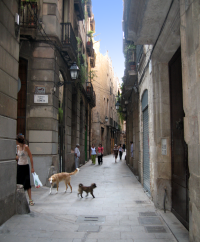 W. Broll, J. Ohlenburg, I. Lindt, I. Herbst, and A.-K. Braun.
Meeting Technology Challenges of Pervasive Augmented Reality Games.
In NetGames '06: Proceedings of 5th ACM SIGCOMM workshop on Network and system support for games, 2006. PDF
W. Broll, J. Ohlenburg, I. Lindt, I. Herbst, and A.-K. Braun.
Meeting Technology Challenges of Pervasive Augmented Reality Games.
In NetGames '06: Proceedings of 5th ACM SIGCOMM workshop on Network and system support for games, 2006. PDF
Abstract: Pervasive games provide a new type of game combining
new technologies with the real environment of the players. While this already poses new
challenges to the game developer, requirements are even higher for pervasive Augmented
Reality games, where the real environment is additionally enhanced by virtual game items.
In this paper we will review the technological challenges to be met in order to realize
pervasive AR games, show how they go beyond those of other pervasive games, and present
how our AR framework copes with them. We will further show how these approaches are applied
to three pervasive AR games and draw conclusions regarding the future requirements regarding
the support of this type of games.
 U. Pankoke-Babatz, I. Lindt, J. Ohlenburg, and S. Ghellal.
Crossmediales Spielen in Epidemic Menace.
In A. M. Heinecke, H. Paul: Mensch & Computer 2006: Mensch und Computer im StrukturWandel. PDF
U. Pankoke-Babatz, I. Lindt, J. Ohlenburg, and S. Ghellal.
Crossmediales Spielen in Epidemic Menace.
In A. M. Heinecke, H. Paul: Mensch & Computer 2006: Mensch und Computer im StrukturWandel. PDF
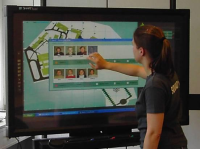 J. Ohlenburg, I. Lindt, and U. Pankoke-Babatz.
A Report on the Crossmedia Game Epidemic Menace.
In 3rd International Workshop on Pervasive Gaming Applications (PerGames 2006), 2006. PDF
J. Ohlenburg, I. Lindt, and U. Pankoke-Babatz.
A Report on the Crossmedia Game Epidemic Menace.
In 3rd International Workshop on Pervasive Gaming Applications (PerGames 2006), 2006. PDF
Abstract: Crossmedia games employ a wide variety of gaming interfaces based on stationary and mobile devices to
facilitate different game experiences within a single game. This article presents the crossmedia game Epidemic
Menace, introduces the game concept, and describes experiences from two Epidemic Menace game events. We
also explain the technical realization of Epidemic Menace, the evaluation methodologies we used, and some
evaluation results.
2005
 W. Broll, I. Lindt, J. Ohlenburg, I. Herbst, M. Wittkämper, and T. Novotny.
An Infrastructure for Realizing Custom Tailored Augmented Reality User Interfaces.
IEEE Transactions on Visualization and Computer Graphics (TVCG), 11(6):722-733, 2005. PDF
W. Broll, I. Lindt, J. Ohlenburg, I. Herbst, M. Wittkämper, and T. Novotny.
An Infrastructure for Realizing Custom Tailored Augmented Reality User Interfaces.
IEEE Transactions on Visualization and Computer Graphics (TVCG), 11(6):722-733, 2005. PDF
Abstract: Augmented Reality (AR) technologies are rapidly expanding into new application areas.
However, the development of AR user interfaces and appropriate interaction techniques remains a complex
and time-consuming task. Starting from scratch is more common than building upon existing solutions.
Furthermore, adaptation is difficult, often resulting in poor quality and limited flexibility with
regard to user requirements. In order to overcome these problems, we introduce an infrastructure for
supporting the development of specific AR interaction techniques and their adaptation to individual
user needs. Our approach is threefold: a flexible AR framework providing independence from particular
input devices and rendering platforms, an interaction prototyping mechanism allowing for fast
prototyping of new interaction techniques, and a high-level user interface description, extending
user interface descriptions into the domain of AR. The general usability and applicability of the
approach is demonstrated by means of three example AR projects.
 J. Ohlenburg and J. Müller.
Interactive CSG Trees Inside Complex Scenes.
In 16th IEEE Visualization 2005 (VIS 2005), 2005. PDF
J. Ohlenburg and J. Müller.
Interactive CSG Trees Inside Complex Scenes.
In 16th IEEE Visualization 2005 (VIS 2005), 2005. PDF
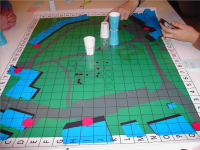 I. Lindt, J. Ohlenburg, U. Pankoke-Babatz, S. Ghellal, L. Oppermann, and M. Adams.
Designing Cross Media Games.
In 2nd International Workshop on Pervasive Gaming Applications (PerGames 2005), 2005. PDF
I. Lindt, J. Ohlenburg, U. Pankoke-Babatz, S. Ghellal, L. Oppermann, and M. Adams.
Designing Cross Media Games.
In 2nd International Workshop on Pervasive Gaming Applications (PerGames 2005), 2005. PDF
Abstract: Cross media games focus on a wide variety of gaming devices including traditional
media channels, game consoles as well as mobile and pervasive computing technology to allow for a
broad variety of game experiences.
This paper introduces cross media games. It addresses
challenges of cross media games and points out game design, technical, commercial and ethical
aspects. A gaming scenario illustrates cross media specific game elements and game mechanics.
Initial results gained in a paper-based version of the gaming scenario are presented.
The paper concludes with an outlook.
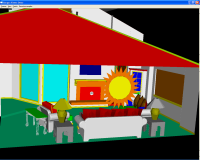 J. Ohlenburg, T. Fröhlich, and W. Broll.
Internal and External Scene Graphs: A New Approach for Flexible Distributed Render Engines.
In VR '05: Proceedings of the IEEE Virtual Reality 2005 (VR'05), 2005. PDF
J. Ohlenburg, T. Fröhlich, and W. Broll.
Internal and External Scene Graphs: A New Approach for Flexible Distributed Render Engines.
In VR '05: Proceedings of the IEEE Virtual Reality 2005 (VR'05), 2005. PDF
Abstract: Render engines or render APIs are a core part of each Virtual Reality
(VR) or Augmented Reality (AR) environment as well as 3D
games. Most existing approaches either focus on rendering speed
for high frame rates or on the presentation of advanced visual features.
However, no approach exists to integrate scene descriptions
based on multiple file formats without converting and thereby partly
destroying the native scene format.
In this paper we will present our approach of internal and external
scene graphs for realizing render engines. We will show how
this approach overcomes existing limitations, while still providing
decent frame rates and rendering features. By using internal scene
graphs for rendering, we use external scene graphs to store format
or application specific information, preserving its native structure
and content.
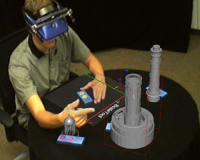 W. Broll, I. Lindt, J. Ohlenburg, and A. Linder.
A Framework for Realizing Multi-Modal VR and AR User Interfaces.
In Universal Access in Human Computer Interaction (HCI 2005), 2005. PDF
W. Broll, I. Lindt, J. Ohlenburg, and A. Linder.
A Framework for Realizing Multi-Modal VR and AR User Interfaces.
In Universal Access in Human Computer Interaction (HCI 2005), 2005. PDF
Abstract: The development of Virtual Reality (VR) and Augmented Reality (AR) applications
still is a cumbersome and error prone task. While 2D desktop applications have very clear standards
regarding user interfaces and a very limited set of common input devices, no standards for VR/AR
applications yet exist. Additionally a wide range of different 3D input devices exists.
In this paper we will present our framework for realizing multi-modal VR and AR user interfaces. This framework
does not rely on a single mechanism, but provides a set of three individual mechanisms complementing each other.
We use an interface markup language for defining cross-platform user interfaces, object behaviors for rapid VR/AR
interaction prototyping, and object-oriented scene graphs for realizing complex application scenarios.
2004
 J. Ohlenburg, I. Herbst, I. Lindt, T. Fröhlich, and W. Broll.
The MORGAN Framework: Enabling Dynamic Multi-User AR and VR Projects.
In VRST '04: Proceedings of the ACM symposium on Virtual reality software and technology, pages 166-169, 2004. PDF
J. Ohlenburg, I. Herbst, I. Lindt, T. Fröhlich, and W. Broll.
The MORGAN Framework: Enabling Dynamic Multi-User AR and VR Projects.
In VRST '04: Proceedings of the ACM symposium on Virtual reality software and technology, pages 166-169, 2004. PDF
Abstract: The availability of a suitable framework is of vital importance for the development
of Augmented Reality (AR) and Virtual Reality (VR) projects. While features such as scalability,
platform independence, support of multiple users, distribution of components, and an efficient
and sophisticated rendering are the key requirements of current and future applications, existing
frameworks often address these issues only partially. In our paper we present MORGAN --- an extensible
component-based AR/VR framework, enabling sophisticated dynamic multi-user AR and VR projects. Core
components include the MORGAN API, providing developers access to various input devices, including
common tracking devices, as well as a modular render engine concept, allowing us to provide native
support for individual scene graph concepts. The MORGAN framework has already been successfully
deployed in several national and international research and development projects.
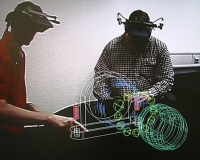 W. Broll, I. Lindt, J. Ohlenburg, M. Wittkämper, C. Yuan, T. Novotny, C. Mottram, A. Fatah, and A. Strothmann.
ARTHUR: A Collaborative Augmented Environment for Architectural Design and Urban Planning.
Virtual Reality and Broadcasting, 1(1), 2004. PDF
W. Broll, I. Lindt, J. Ohlenburg, M. Wittkämper, C. Yuan, T. Novotny, C. Mottram, A. Fatah, and A. Strothmann.
ARTHUR: A Collaborative Augmented Environment for Architectural Design and Urban Planning.
Virtual Reality and Broadcasting, 1(1), 2004. PDF
Abstract: Projects in the area of architectural design and urban planning typically engage
several architects as well as experts from other professions. While the design and review meetings
thus often involve a large number of cooperating participants, the actual design is still done
by the individuals in the time in between those meetings using desktop PCs and CAD applications.
A real collaborative approach to architectural design and urban planning is often limited to early
paper-based sketches.
In order to overcome these limitations, we designed and realized the
ARTHUR system, an Augmented Reality (AR) enhanced round table to support complex design and
planning decisions for architects. While AR has been applied to this area earlier, our approach
does not try to replace the use of CAD systems but rather integrates them seamlessly into the
collaborative AR environment. The approach is enhanced by intuitive interaction mechanisms that
can be easily configured for different application scenarios.
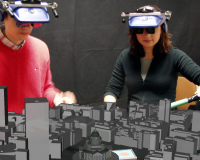 W. Broll, I. Lindt, J. Ohlenburg, M. Wittkämper, C. Yuan, T. Novotny, C. Mottram, A. Fatah, and A. Strothmann.
ARTHUR: A Collaborative Augmented Environment for Architectural Design and Urban Planning.
In Proceedings of HC 2004, 2004. PDF
W. Broll, I. Lindt, J. Ohlenburg, M. Wittkämper, C. Yuan, T. Novotny, C. Mottram, A. Fatah, and A. Strothmann.
ARTHUR: A Collaborative Augmented Environment for Architectural Design and Urban Planning.
In Proceedings of HC 2004, 2004. PDF
Abstract: Projects in the area of architectural design and urban
planning typically engage several architects as well as
experts from other professions. While the design and
review meetings thus often involve a large number of
cooperating participants, the actual design is still done by
the individuals in the time between those meetings using
desktop PCs and CAD applications. A real collaborative
approach to architectural design and urban planning is
often limited to early paper-based sketches.
In order to overcome these limitations we designed and
realized the Augmented Round Table, a new approach to
support complex design and planning decisions for
architects. While AR has been applied to this area earlier,
our approach does not try to replace the use of CAD
systems but rather integrates them seamlessly into the
collaborative AR environment. The approach is enhanced
by intuitive interaction mechanisms that can be easily
configured for different application scenarios.
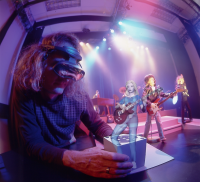 W. Broll, S. Grünvogel, I. Herbst, I. Lindt, M. Maercker, J. Ohlenburg, and M. Wittkämper.
Interactive Props and Choreography Planning with the Mixed Reality Stage.
In Proceedings of ICEC 2004, 2004. PDF
W. Broll, S. Grünvogel, I. Herbst, I. Lindt, M. Maercker, J. Ohlenburg, and M. Wittkämper.
Interactive Props and Choreography Planning with the Mixed Reality Stage.
In Proceedings of ICEC 2004, 2004. PDF
Abstract: This paper introduces-the Mixed Reality Stage-an interactive Mixed Reality environment
for collaborative planning of stage shows and events. The Mixed Reality Stage combines the presence of
reality with the flexibility of virtuality to form an intuitive and efficient planning tool. The planning
environment is based on a physical miniature stage enriched with computer-generated props and characters.
Users may load virtual models from a Virtual Menu, arrange those using Tangible Units or employ more sophisticated
functionality in the form of special Tools. A major feature of the Mixed Reality stage is the planning of
choreographies for virtual characters. Animation paths may be recorded and walking styles may be defined in
a straightforward way. The planning results are recorded and may be played back at any time. User tests have
been conducted that demonstrate the viability of the Mixed Reality Stage.
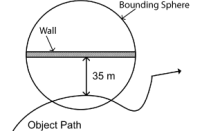 J. Ohlenburg.
Improving Collision Detection in Distributed Virtual Environments by Adaptive Collision Prediction Tracking.
In VR '04: Proceedings of the IEEE Virtual Reality 2004 (VR'04), 2004. PDF
J. Ohlenburg.
Improving Collision Detection in Distributed Virtual Environments by Adaptive Collision Prediction Tracking.
In VR '04: Proceedings of the IEEE Virtual Reality 2004 (VR'04), 2004. PDF
Abstract: Collision detection for dynamic objects in distributed virtual environments is still an
open research topic. The problems of network latency and available network bandwidth prevent exact common
solutions. The Consistency-Throughput Tradeoff states that a distributed virtual environment cannot be
consistent and highly dynamic at the same time. Remote object visualization is used to extrapolate and
predict the movement of remote objects reducing the bandwidth required for good approximations of the
remote objects. Few update messages aggravate the effect of network latency for collision detection.
In this paper new approaches extending remote object visualization techniques will be demonstrated to
improve the results of collision detection in distributed virtual environments. We will show how this
can significantly reduce the approximation errors caused by remote object visualization techniques.
This is done by predicting collisions between remote objects and adaptively changing the parameters
of these techniques.
Last modification: Tuesday, 28. January 2014